Are you working on setting up the perfect habitat for a leopard gecko? One of the best places to start is by choosing a great substrate. Substrate has a large impact on the health and happiness of a Gecko.
Picking the best Leopard Gecko substrate is hard for beginners. On top of the large number of options, it also requires knowledge of their habitat and lifestyle. The importance of a substrate is commonly overlooked in favor of more exciting things like aesthetic terrariums and themed décor.
Beginners should know that not all substrate for Leopard Geckos is good. The options can easily be narrowed down based on material, price and size.
The ideal substrate is one that is safe, easy to clean, durable, cost-effective and looks nice. Keep reading for a complete guide to the worst and best substrates for leopard geckos…
All About Leopard Gecko Substrate
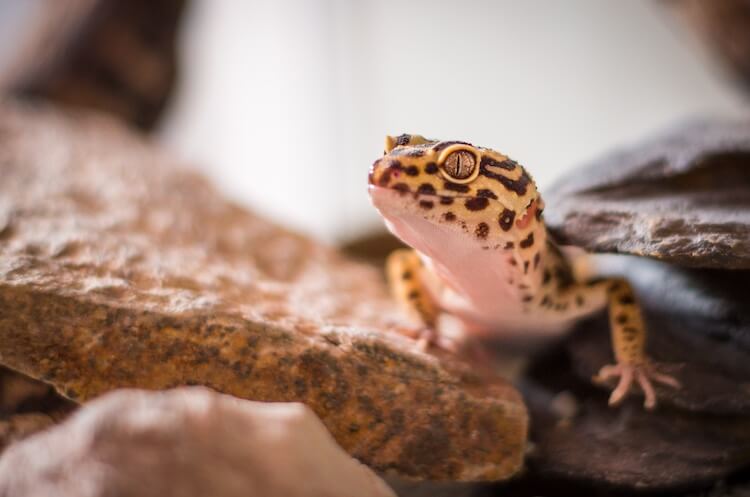
Leopard Geckos are very good at climbing, but they are actually ground-dwelling lizard. They spend most of their time directly on substrate. This is especially true for pet geckos who run, walk, sleep and eat on the ground. The quality of their substrate is extremely important.
A common misconception about leopard geckos is that they are desert animals that live in hot, sandy environments. This leads to new owners putting sand in their geckos’ enclosure. This is not only wrong, but it is also very dangerous to their health.
Leopard Gecko are actually from Afghanistan, Iran and Iraq.
Their habitat is largely made up of barren grasslands and rocky outcrops. There is also plenty of vegetation cover and places to hide from predators and the sun.
The substrate found in their natural range is mostly hard, clay and gravel covered in a thin layer of sand and scattered with boulders, shrubs and grasses.
Substrate for a Leopard Gecko should mimic their wild habitat as closely as possible. However, replicating the environment of the Middle East in a terrarium is expensive and not easy.
Instead, there are a number of alternative substrates that are easy to find, install and safe to use.
Although there are many great substrates for leopard geckos, there are also some that are highly unsafe. Adding to the confusion, a few substrates (especially sand) are marketed as suitable for geckos when they are actually not.
Below is a complete list of Leopard Gecko substrates. Not every option on the list below is suitable for this species, and those that are have pros and cons. We will break down the best and worst substrates in the section below:
- Bioactive
- Clay
- Coconut Fiber (Eco Earth, Coir)
- Corn Cob
- DIY Blended Substrate / Naturalistic Mix
- Gravel
- Ground Walnut Shell
- Linoleum
- Moss, Sphagnum Peat Moss Mix
- Newspaper Or Paper Towel
- Pine, Fir, Or Cedar Products
- Reptile Carpet
- Reptile Sand Mat
- Sand
- Shelf Liner
- Slate Tiles, Stone Slates
- Wood Chips And Shavings
9 Best Leopard Gecko Substrates
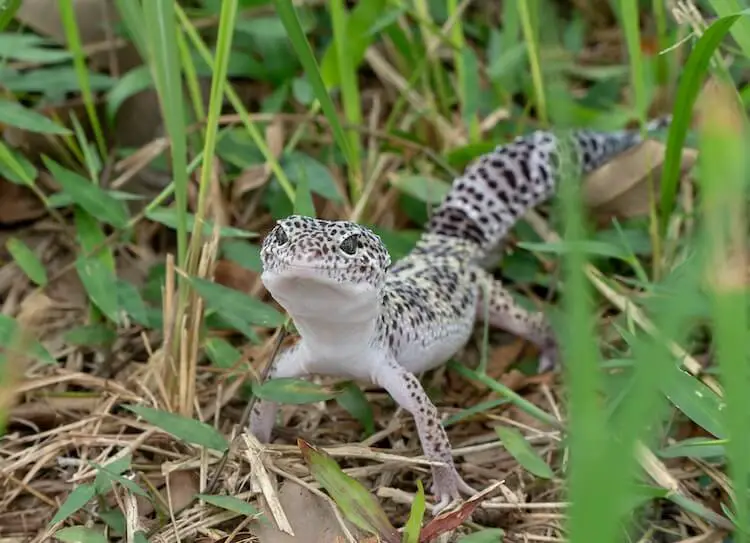
Most importantly Leopard Gecko substrate should be safe and not pose a risk of impaction or bacterial growth. The best substrates will also allow them to show off their natural behaviors such as: digging, climbing and creating burrows. These activities are fun to watch and also provide mental enrichment to a Gecko.
1. Bioactive
Bioactive enclosures are miniature ecosystems with natural soil, live plants and a “cleanup crew” of live bacteria to break down waste. Bioactive substrates closely mimic the natural habitat of leopard geckos.
A bioactive substrate consists of several layers of gravel (for drainage), soil and clay mixtures. It also has live plants and branches.
This substrate looks very natural and highlights the exotic and wild appearance of your leopard gecko. It also allows your Gecko to interact with the substrate as it would in the wild: digging, burrowing, and finding small arthropods to eat.
Another great benefit of a bioactive substrate is that it requires much less cleaning than other substrates because of the other organisms that live in it.
Once set up and fine-tuned for temperature and humidity, bioactive enclosures require little maintenance and cleaning. While the white urates of your gecko’s poop should still be removed, the “cleanup crew” and beneficial bacteria will break down the dark, organic part.
Unfortunately this substrate is the most difficult to set up properly.
Setting up a bioactive enclosure is expensive and time-consuming. It also requires a strong knowledge of horticulture and self-sustaining ecosystems. Depending on the size of your reptile tank it will cost anywhere from $75 to $300.
2. DIY Blended Substrate
A do-it-yourself substrate is a much cheaper alternative to a bioactive setup. It is a cheap and simple way to add a unique, natural look to your gecko’s enclosure.
We recommend using a 50:30:20 mix of organic topsoil, play sand and clay. Do not use calcium sand or beach sand in the mix. Also make sure the soil and sand are free from fertilizers and pesticides.
Each DIY mix will be slightly different in consistency each time. However, this substrate holds its shape, while still being pliable enough to for your gecko to dig in.
If you decide to use a blended substrate then mix it and leave it in the tank for 1-2 weeks before adding your lizard. This will let you adjust temperatures, while seeing how sturdy the substrate is as it dries.
Blended substrates should be replaced once a year to prevent a buildup of bacteria. However, it is very cheap and $35 is enough for two or three mixes.
3. Reptile Sand Mat
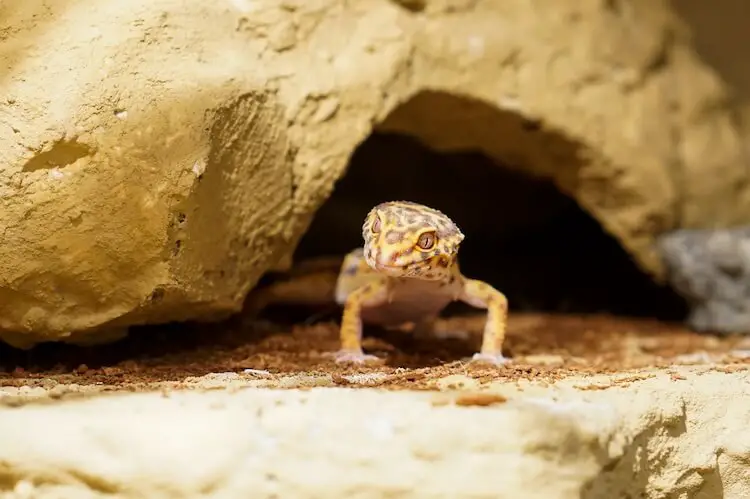
Reptile sand mats are a great substrate for Leopard Geckos. They combine the simplicity of reptile carpet with the natural look of a DIY or bioactive mix.
They have a rocky, sandy appearance that gives your Gecko a firm grip and no loose grains that could be accidentally swallowed. It is best to purchase a finer-grain sand mat because larger grains may be rough on your gecko’s stomach.
Sand mats are very affordable at $10 to $40 and can be found at most pet stores.
These mats range in size from 11” x 11” to 47.5” x 17.5”. Installing them is as simple as cutting them with a box cutter. They have no adhesive backing and so can be removed easily for cleaning. We prefer reptile sand mats to lino as these mats carry no risk of melting and can be removed from the tank easily.
While the rough texture can make spot-cleaning difficult, this mat can be deep cleaned every two weeks by removing it and washing it with soap and water.
4. Stone Tiles
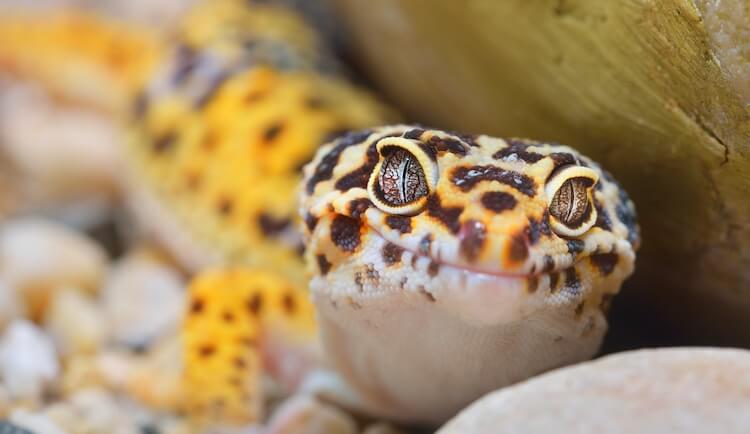
Stone, slate and ceramic tiles are excellent additions to a leopard gecko’s enclosure. They need to be layered on top of another substrate like carpet or paper towels to help regulate the temperature.
Tiles are easy to install, cheap to purchase and come in a huge selection of colors and styles.
Ceramic tiles sell for $1 to $8 per slab, with standard sizes of 6” x 6”, 2” x 3”, 12” x 12” and 3” x 8”.
Installing tiles is as easy as laying them down in the enclosure—no grout or putty is needed. This also makes it easy to remove, rearrange, or stack tiles quickly. A downside of this substrate is that each tile may need to be trimmed to a specific size. This cannot be done without a stonecutter.
Stone and ceramic are also fantastic conductors.
They are ideal for heat-loving lizards like leopard geckos because they hold a lot of heat, both from under-tank heaters and overhead heat lamps. The rough texture also mimics the rocky outcrops where geckos live in the wild.
Cleaning tiles is as simple as wiping them down. While they should be spot cleaned every day, tiles are nonporous and only need to be deep cleaned once a month.
5. Clay
In pet stores clay is commonly sold as “excavator clay” or “self-hardening clay”. When mixed with water, the clay is soft and can be molded into tunnels, caves and ledges. As it dries the clay will harden. This clay’s dryness makes it very easy to spot-clean.
Excavator clay typically sells for $10 to $15 for a 10-pound bag, which is suitable for a 20-gallon long terrarium.
Clay holds heat well, feels natural to geckos and gives enclosures an organic look. It is very popular with many herpetologists. However, it can be messy to work with and is not easily replaceable.
For best results, plan and construct clay structures prior to adding your reptile.
6. Reptile Carpet
Reptile carpet is a very popular substrate for Leopard Geckos, bearded dragons and many more reptiles.
Carpet is soft and nonabrasive. It is a good compromise between a natural substrate (e.g. bioactive) and an artificial one (e.g. newspaper). It is also more sustainable and attractive than paper towels but is just as absorbent.
Reptile carpet is sold at pet stores for $5 for a 10” x 20” roll or $20 for a 15” x 48” roll.
We recommend purchasing two rolls so one can be used in the enclosure while the other is in the wash. Unfortunately, this reduces the cost-effectiveness of this substrate, especially since it should be replaced after five washes.
If you do not mind spending more money over time, reptile carpet is a great choice. It is a high-quality substrate with zero risk of impaction.
7. Newspaper or Paper Towel
Newspaper is a simple, cheap and safe leopard gecko substrate.
It is widely used for many types of geckos and is especially handy for juveniles who create a lot of waste and have higher risks of impaction.
Two layers of paper towel or newspaper should be laid down in a tank.
Be careful placing paper towels directly over an under-tank heater. They may get too hot and require a barrier layer of cardboard. You can test surface temperatures with an infrared temperature gun to make sure it is not too hot.
Due to its absorbency, paper towels must be replaced every week. Expect to go through one newspaper per month for a 20-gallon enclosure.
8. Lino
Linoleum is a mat-like flooring that looks like stone or hardwood.
This easy-to-install substrate is good for leopard geckos, though it does come with a major downside. Lino’s greatest flaw is its peel-and-stick method of installation. This makes it very difficult to remove once set in place. The adhesive glue can also be melted by the high heat of a leopard gecko’s enclosure.
Linoleum is very cheap at usually $5 per square foot.
It also comes in a variety of styles (e.g. stone tiles, wood slats, or ceramic) and is lightweight and flexible.
Cleaning lino is hassle-free and can be done by wiping it down with a damp cloth and non-phenol cleaning agent. As long as it is cleaned regularly, there is no need to replace linoleum. It is a sustainable and long-lasting substrate.
9. Shelf Liner
Shelf Liner may seem like a surprising substrate, but it can be used.
It is affordable, can be purchased in bulk, and is simple to use. An 18” x 100” roll of standard shelf liner can be purchased for $10 at a hardware store. Try and find one that does not have an adhesive backing and is not perforated.
While not an attractive or natural substrate, shelf liner is practical, safe and cheap.
The largest problem with using shelf liner is that it is an insulator, not a conductor.
This means you may need to increase the output of your heat fixtures to get the liner to a good surface temperature for basking.
Worst Substrate for Leopard Geckos
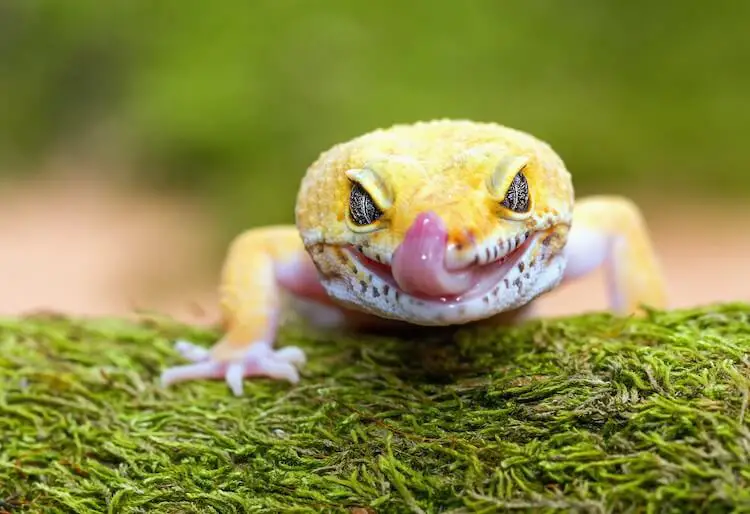
There are many factors to consider when picking a leopard gecko substrate. Your choice of substrate will depend on budget, tank size, experience, and how natural you want it to be.
A substrate that works for one tank set up may not work for another. However, all of the substrates below should never be used for any set up:
- Sand
- Pine, Fir and Cedar
- Coconut Fiber
- Corn Cob
- Ground Walnut Shell
- Wood Chips
- Gravel
- Sphagnum Moss
Sand is the top selling substrate, but it should not be used. Unfortunately, there are many reptile owners who continue to spread misinformation by claiming sand is safe for leopard geckos. Sand and other loose substrates can cause impaction if accidentally eaten. Soft sand is very different from their natural hard clay-like sand.
Pine, Fir and Cedar are all types of wood that contain oils that are toxic to most reptiles. Because of this, pine, fir, or cedar bedding should not be used in a gecko’s enclosure.
Coconut Fiber should not be used as a Leopard Gecko substrate. It is easy for your lizard to accidentally eat it by accident. This substrate also holds a lot of moisture which can cause respiratory and skin infections. The hot temperatures needed by leopard geckos also cause coconut fiber to become dusty.
Corn Cob granules are cheap to buy in bulk but should not be used. If wet, this substrate causes rapid fungal and bacterial growth that leads to mouth rot and other issues. The size of the granules are also large enough that they can become lodged in your gecko’s throat if picked up by licking.
Ground Walnut Shell is sometimes sold as “desert sand”. It may look natural, but the dangers of this substrate greatly outweigh the benefits. The small particles are sharp and can cause impaction and gastrointestinal inflammation in leopard geckos. Similar to corn cob, walnut shells are also prone to growing bacteria and fungi if wet.
Wood Chips are too abrasive and loose. Insect prey can also easily escape and hide in wood chips, making them almost impossible to find.
Gravel can be used as a substrate, but only when combined with another substrate like clay or gravel. By itself, gravel is too loose to provide an effective ground cover. In addition, many types of gravel have sharp edges that can irritate the thin skin of your gecko’s underbelly and feet. Gravel also carries the risk of collapsing on top of a leopard gecko as it digs.
Sphagnum Moss is suitable for use in a moist hide for shedding, but should not make up the entire substrate because too much will hold excess moisture and allow for bacterial and mold growth. There is nothing wrong with using moss to enhance décor as long as it is not enough to impact the humidity.
What Is The Best Substrate?
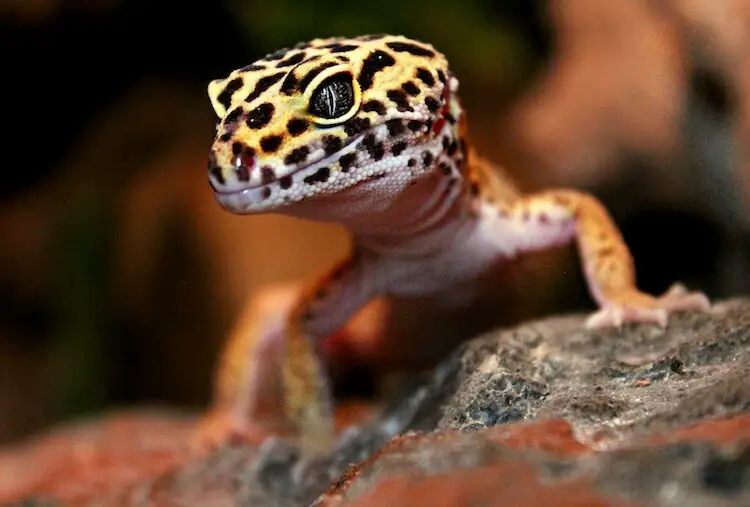
The two best leopard gecko substrates are bioactive or stone tiles.
Bioactive substrates are perfect for keepers with a larger budget, more experience, and are willing to put in research beforehand. A bioactive setup is mostly self-cleaning and low maintenance once built. In addition, this substrate lets your gecko exhibit its natural behaviors and is very beautiful.
However, bioactive setups are very expensive and are best for adult geckos only.
If a bioactive substrate seems too time-consuming, then stone tiles are a great alternative. This substrate is cheap, durable, easy to clean, and still provides your gecko with a familiar rocky surface to walk on. Tiles are also suitable for lizards of all sizes and ages.
The best substrate will make your lizard feel more at home. This will reduce their stress and help them live a longer, happier life.
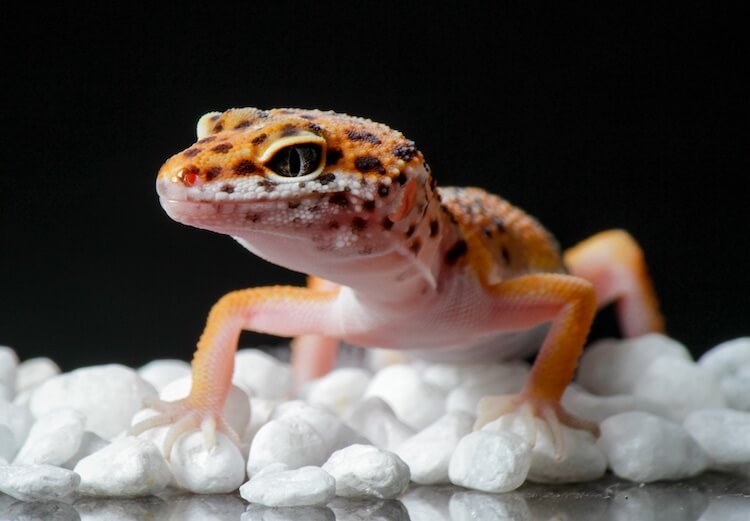
Summary Table
| Substrate | Suitable | Pros | Cons |
|---|---|---|---|
| Bioactive | Yes | Mimics natural habitat and promotes digging. | Difficult to set up. |
| Clay | Yes | Allows you to build natural caves and burrows. | Messy installation. |
| Coconut Fiber | No | Cheap to buy in bulk. | Retains a lot of moisture and has the risk of impaction. |
| Corn Cob | No | Easy to use and discard. | Promotes bacterial growth and has the risk of impaction. |
| DIY Blended Substrate | Yes | Natural and allows for digging. | Can’t be purchased, must be made. |
| Gravel | No | Durable and long-lasting. | Can harm your gecko’s skin, especially a morph’s skin. |
| Ground Walnut Shell | No | Looks like natural sand. | Risk of impaction. |
| Linoleum | Yes | Cheap and attractive. | Difficult to remove and may melt. |
| Sphagnum Moss | No | Natural look and soft texture. | Holds too much moisture. |
| Newspaper/Paper Towel | Yes | Easy to clean and dispose. | Not sustainable. |
| Pine, Fir, or Cedar | No | Available in bulk. | This wood contains oils toxic to reptiles. |
| Reptile Carpet | Yes | Nice look and soft texture. | Gets dirty quickly and is expensive. |
| Reptile Sand Mat | Yes | Looks natural and has no risk of impaction. | Hard to spot-clean. |
| Sand | No | Gives a desert look. | Not safe and has a high risk of impaction. |
| Shelf Liner | Yes | Cheap and sturdy. | Does not hold heat. |
| Ceramic or Slate Tiles | Yes | Looks natural and is a great conductor. | Difficult to cut to size. |
| Wood Chips and Shavings | No | Cheap and easy to replace. | Sharp edges may cause splinters or impaction. |
Is there a perfect leopard gecko substrate we missed? Let us know in the comments.
Choosing a Substrate
Substrates can impact the happiness and well-being of your Leopard Gecko. There are many opinions out there, so you are not alone. You need to consider the gecko’s natural habitat and try to balance that with the convenience of cleaning up after your pet.
That being said, choosing the wrong substrate can impact the life of your gecko. Leopard geckos should live much longer than two years in captivity, the average being 10 to 20 years.
The ideal substrate needs to be safe and not pose a risk of bacterial growth that can cause your gecko disease. It also needs to allow for natural behavior like hiding, digging, climbing, and burrowing to keep your little guy (or girl) happy and active.
Bioactive Substrate: You start with a layer of gravel for drainage, soil, and clay mixtures, then add live plants and branches. Once these are set up and “fine-tuned” for temperature and humidity, they require little maintenance; however, they are not always easy to set up.
The white urates your gecko produces will need to be removed by you. Good bacteria in the environment will take care of dark organic matter.
You may need someone else to set up your enclosure.
DIY: It is recommended to mix 50% organic top soil, 30% play sand (Do Not use beach sand or beech wood chips or calcium sand), and 20% clay. Do make sure your substances are pesticide and fertilizer-free.
If you blend your own, mix it, put it in the tank, and let it sit 1-2 weeks before adding your gecko. This allows the temperatures to regulate. Blended substrates should be replaced once a year to prevent bacteria buildup.
Ceramic Tile: These may need a bottom substrate of paper towels or carpet to help regulate temperature. They are easy to remove and clean periodically. Do not grout them down. If you need to cut them, make sure they do not have sharp edges. Plants, rocks, and hiding shelters need to be added as well. Tiles absorb heat, so adding a heat lamp overhead or under the tiles may be an option to consider. You can add earthenware and terracotta clay pots to your vivarium; however, they are hard to clean if they are unglazed.
Reptile Carpet: This can be used, but it needs to be replaced every five washes; it is better than paper towels that can be used in a pinch.
Having either an under a heat source or overhead heat source is important, but it needs a thermostat to regulate the temperature. It is nice to have a thermometer as well to keep things around 80 degrees.
The worst substrate options are gravel, wood chips, sand, coconut fiber, wood chips, to name a few. Sand can be eaten and cause bowel impaction. Chips from trees like fir, cedar, and pine have an oil that is toxic to most reptiles. Coconut fiber can be eaten, which holds moisture and can cause respiratory problems. Gravel alone can be sharp, and if digging can collapse on the gecko.

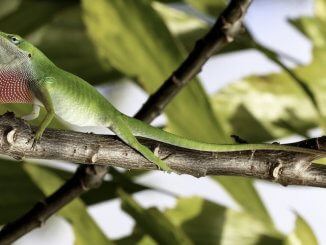
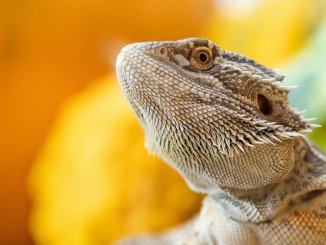
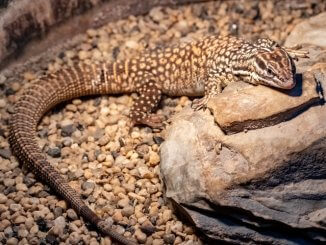

Can you use toilet paper for a flooring?
no toilet paper when it gets wet clumps up and when wet becomes a real mess in handling it also gets stuck to animals feet and body to easily. its not good on the digestive system.
I would think toilet paper would rip too easily. If money is an issue, Newspaper or paper towels might be the best choice.
Paper towels are stronger than toilet paper for flooring in a leopard gecko enclosure. However, many pet owners choose ceramic tile and just clean that up. Toilet paper is made to dissolve easily in water and may be too thin and disposable for everyday use.
I am looking at getting my first baby Leopard Gecko and do not know what substrate to go for there are so many options and opinions I could do with some guidance.
We just added some more content at the bottom of the article to help you
For the DIY, is it 50% by weight or by volume? Clay is heavier than soil or sand.
These relative quantities refer to volume. You can measure by sight, you do not need to weight them.